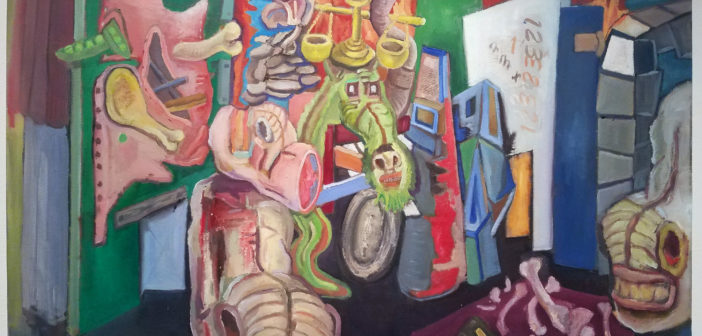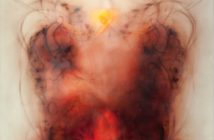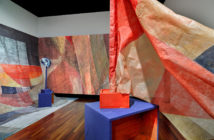A green, furry fiend lingers in the center of A Brief Case, one of Stuart Diamond’s latest paintings. Behind this Grinch-like ghoul, the scales of justice teeter on an elephant trunk, imperiled. A curtain of flame sizzles in the distance. In the corner rests a pile of bones, guarded by an ox muzzle, teeth bared and hungry for more.
Like most of the work in Diamond’s Trunks and Tales—on view at Rhode Island College’s Bannister Gallery through July 14, by appointment—A Brief Case mixes autobiography with cultural lament. The exhibition concerns Diamond’s life and the United States’ political milieu, as in The Spoils (2016/2017), an overstuffed and ominous take on middle America, its center jammed with veggies, noodles, and abstract shapes. While broader narratives might lurk beneath, these paintings are largely experienced as embodiments of craft and structure: composition, color, drawing, time and space. Still, Diamond says he’s “uncomfortable with work that knows exactly how it's going to get to the end.” There is always room for serendipity, error, and revision.
Diamond’s subject matter is often chosen for symbolism but ultimately arranged according to graphic interest. Take the omnipresent motif of ox muzzles. The ox is “totally manipulated,” Diamond says, “a working creature” who’s been “castrated.” In his renderings, the ox is nothing more than snout and maw, and thus “sightless.” Visually, the oxen function as foreboding agents of change, dark mementos of an oppressed working class, but also as Cheshire Cats, their bodies reduced to a grin, inviting viewers into worlds built on an untypical but compelling logic. A tantalizing diversity of imagery–sandwiches, slabs of meat, shrimp, wooden planks, tiny bricks, fighter jets, buffalo, cleavers and pure abstraction—furthers the paintings’ distinctive sense of (dis)order.
Despite their surreal contents, these tableaus appear too considered and rich to be called hallucinatory. There’s a marvelous tension between gluttony and modesty in Diamond’s work. He prepares his feasts with equal attention to color and form, allowing them to occupy space as abstractions do: flowing, expressive, unbound by linear perspective. As a student of second- and third-generation abstract expressionism, he spent the 1980s in New York, showing at prestigious spots like the now-shuttered McKee Gallery. Diamond’s earlier pieces were more literally built, with tools and junk strewn about, eventually coalescing through some macho magic into massive, object-heavy constructions.
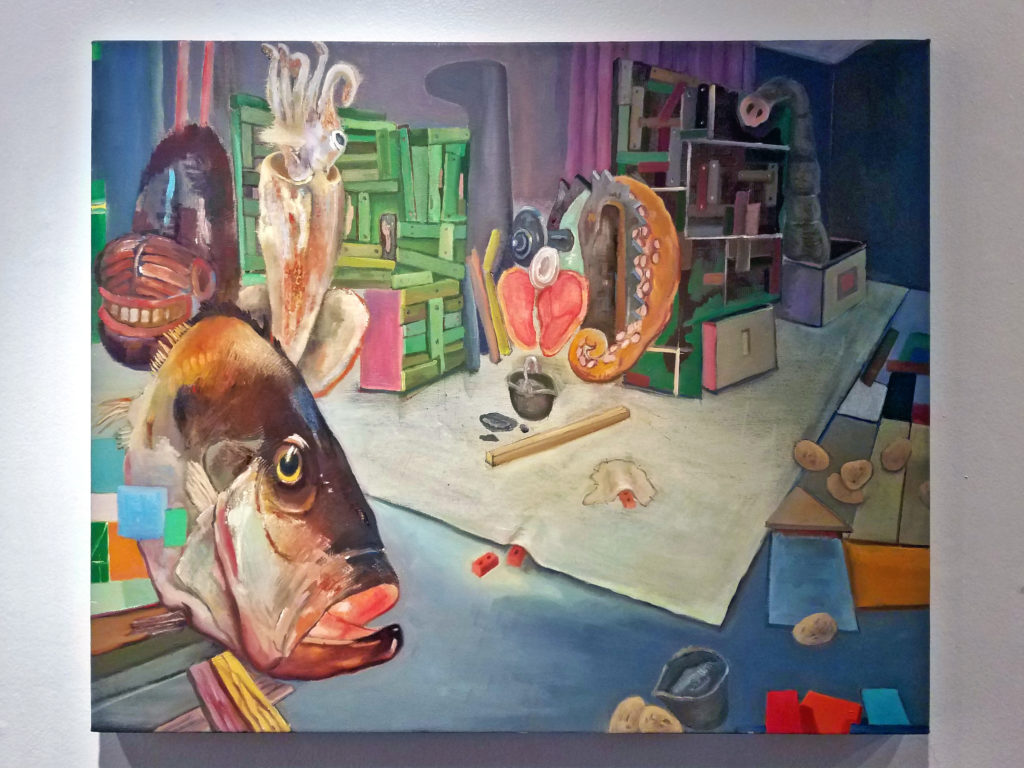
Stuart Diamond Hook, Line and Sinker
Now, a matured Diamond “pays attention to color in a way I hadn’t done with the constructions at all.” No need for adornments; oil paint will suffice. Since his previous show at New York’s Skoto Gallery, Diamond has updated and brightened his palette, but his coloration remains largely sober. Witness the contemplative light of Hook, Line and Sinker (2017), which creeps from underneath a cloth to slowly illuminate a squid, potatoes and squares.
Holden O'Brien, Diamond's studio manager, was a frequent presence in his studio as he created this body of work. She says the paintings originally “orbited around this notion of an acquired palate,” something still useful when dining on Diamond’s paintings. There are notes of Chardin (“a painter of the French middle class,” Diamond says) in the peripheral elements, such as crackers filing along the edge of Mixed Signals (2017). Diamond is also a big admirer of Giorgio Morandi. From this Italian master of still-life, Diamond borrows a draftsman’s instincts and excitement for drawing. And while his methods are not as opulent as still-life painters like Jan Weenix, Diamond retains some of their violence with his assortments of meats and phantom animals (elephants, oxen, fish, lobsters), imagery as visceral as it is amusing.
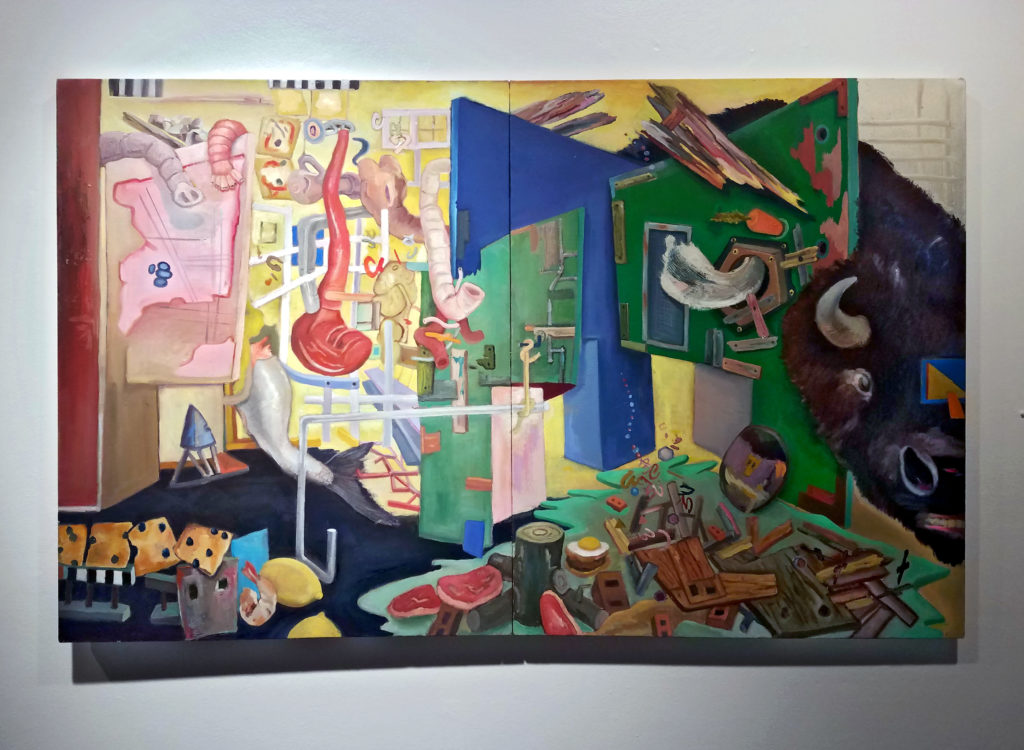
Stuart Diamond Mixed Signals
Diamond’s attitude toward furnishing space recalls more recent art history. In his amalgams of viewpoints and collisions, where everything seems to happen simultaneously, one is reminded of the historical hodgepodges of David Salle and Sigmar Polke. As for material technique, Diamond is closer to his contemporary Elizabeth Murray, with whom he shares a use of opaque color and squirmy, writhing shapes. There are also shades of Philip Guston, not only in Diamond’s mark-making but in his reminder that cartooning and abstraction are neighboring territories. Notice in Mixed Signals (2017) the cut tree flanked by pork chops and an egg sandwich; it could almost be the log from Ren & Stimpy.
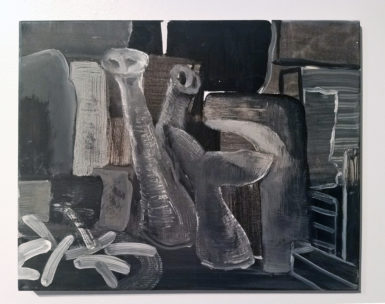
Stuart Diamond Trunks and Tales (Study)
Diamond’s compositional deftness is often satisfying, but perhaps not for the untrained eye. Trunks and Tales might appear muddled or confusing to those unacquainted with how a painting comes together, and Diamond notes that some viewers have found his pictorial buffets difficult to digest.
Alongside this sophistication is subtlety—of coloration, of reference, of form—that gives the viewer more space to feel and think their way through what could otherwise be dizzying arrays of imagery. The strength of these artworks is in their thoughtful, witty architecture, evidence that Diamond is a painter’s painter. Objects, shapes, and foods assume numerous identities in the wilderness of Diamond’s sceneries. Abundance from one vantage point becomes gushing excess from another. These paintings might only be grasped in entirety by their maker, yet they are generous to the audience, open to a glut of interpretations. Perhaps the oxen’s smiles are not delirious, but brief flashes of their creator’s confidence.

